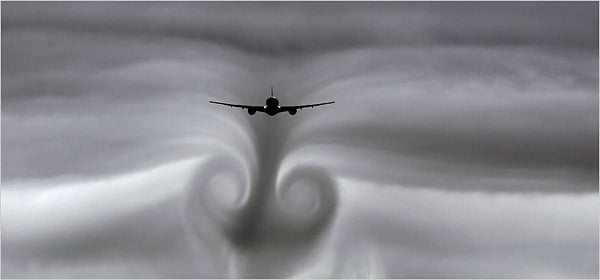The wingtip vortices in the wake of a commercial airliner distort the clouds as the plane descends. Wingtip vortices form as a result of high pressure air from the underside of the wing accelerating around the wingtips to reach the low pressure on top of the wing. They can be hazardous to other (lighter) aircraft. They also contribute to downwash that decreases the effective lift of a wing. Geese use the same mechanism to their advantage when flying in a V-formation, and some snakes use it to glide.
Tag: clouds

Cloud Ocean
Time-lapse photography is great for capturing the fluid motion of clouds over the course of a day.

Hole-Punch Clouds
These hole-punch clouds seen over Myrtle Beach, SC were probably caused by three aircraft flying in military formation. When airplanes pass through supercooled water vapor, the acceleration of air over the wing causes a pressure drop that can flash-freeze the water vapor, resulting in a localized snow shower. See National Geographic for more. #

Airplanes Creating Snow
Scientists now think that that airplanes may be responsible for increasing local snowfall by flash-freezing supercooled water vapor in clouds. Water droplets can persist in the atmosphere to temperatures of -42 degrees Celsius. But when an airplane’s wing passes through moist air, the acceleration of the air passing over the wing causes a pressure decrease that can drop the temperature by as much as 19 C, causing the water droplets to form ice crystals immediately. (The particulate matter in the aircraft exhaust probably also aids this process.) The same behavior can also create holes in clouds and cause ice to form on the wings. # (Related behavior: vapor cones)
Photo credit: lhoon

Recreating Saturn’s Hexagon
In the 1970s, the Voyager spacecraft discovered a hexagon near Saturn’s north pole that defied explanation for years. However, researchers have since simulated the shape in a laboratory by placing a fast-spinning ring on the top surface of a slowly spinning column of fluid. Fluorescent dye is used to visualize the flow pattern. #

Kelvin-Helmholtz Instability
The Kelvin-Helmholtz instability occurs when velocity shear is present in a single fluid or when two different fluids have a velocity difference across their interface. As shown in this numerical simulation, the instability produces a fractal-like pattern of eddies turning over on themselves. The Kelvin-Helmholtz instability is commonly found in nature between cloud layers. #
ETA: It looks like animated GIFs may not work with Tumblr. Be sure to click on the picture to see the animation on Wikipedia.




